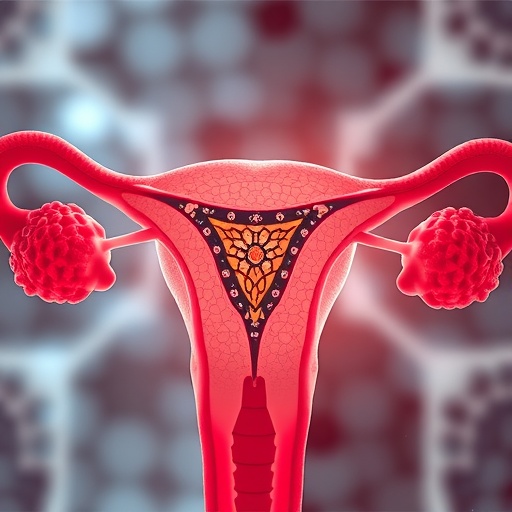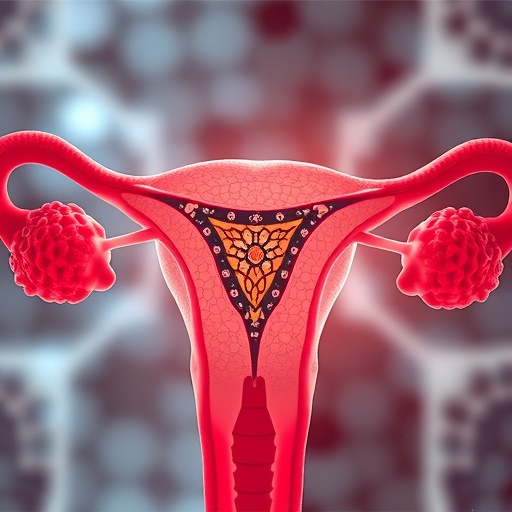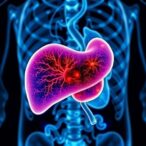
In recent years, the realm of reproductive medicine has witnessed groundbreaking advancements, particularly in the treatment of intrauterine adhesions. These adhesions, often leading to significant reproductive challenges, have sparked intense research in both medical and scientific communities. A particularly promising study authored by Pan, Y., Chang, M., and Zhang, W. et al., titled “Enhanced Improvement of Menstrual Blood Derived Endometrial Stem Cells Encapsulated in Cross-Linked Hyaluronic Acid on Intrauterine Adhesions,” delves into innovative methodologies that harness the potential of endometrial stem cells for therapeutic applications.
The study focuses on the utilization of menstrual blood-derived endometrial stem cells (MDESCs), which present a compelling alternative to traditional cell sources due to their accessibility and regenerative capabilities. MDESCs have displayed an inherent ability to differentiate into various cell types, thereby holding immense promise for repairing damaged tissues. The study aims to elucidate the specific workings of these cells when encapsulated in cross-linked hyaluronic acid, a biocompatible substance known for its significant role in promoting cell adhesion and tissue regeneration.
The authors begin by detailing the physiological context of intrauterine adhesions, which can stem from various causes, including surgical trauma, infections, and endometriosis. These adhesions can manifest as Asherman’s syndrome, a condition characterized by the formation of fibrous scar tissues within the uterine cavity. Not only do such conditions interfere with normal reproductive functions, but they also pose substantial challenges for women aiming to conceive.
Through the innovative use of MDESCs, the researchers aim to find an effective means of alleviating intrauterine adhesions. The cross-linking of hyaluronic acid is particularly noteworthy, as it creates a supportive microenvironment for these stem cells. This method not only protects the encapsulated cells but also augments their viability and promotes cellular activities essential for tissue healing. The encapsulation process encapsulates the cells within a hydrophilic gel matrix, allowing for controlled release and improved interaction with the surrounding tissue.
In conducting their experiments, the researchers adopted a comprehensive approach, observing the interactions between the encapsulated cells and the endometrial tissue in vitro. The findings indicated a marked enhancement in cell proliferation rates and tissue regeneration capabilities when MDESCs were utilized in conjunction with cross-linked hyaluronic acid compared to control groups. This synergy between the cells and the biomaterial points toward a potentially effective strategy for treating intrauterine adhesions.
Furthermore, the study examines various biochemical markers that suggest the encapsulated cells not only survived the harsh intrauterine environment but thrived, contributing to decreased inflammation and promoting healing. These findings highlight the importance of MDESCs in regenerative medicine, particularly in gynecological applications, where conventional treatments often fall short.
A critical phase of the research involved preclinical trials, where the safety and efficacy of the treatment were closely monitored. The results emerged as encouraging, showing a significant reduction in adhesion formation and improved uterine function. This offers hope to a substantial number of women suffering from the debilitating effects of intrauterine adhesions, enabling them to regain fertility prospects.
The implications of this study extend far beyond the immediate benefits for treatment. If validated through further clinical testing, this method could drastically change the landscape of reproductive health, providing a new standard of care tailored to patients suffering from similar conditions. With the potential for less invasive alternatives, women might find renewed optimism in their journeys toward motherhood.
As the authors conclude, the encapsulation of menstrual blood-derived endometrial stem cells in cross-linked hyaluronic acid represents a frontier in regenerative medicine. Their approach not only emphasizes the innate potential of stem cells but also the importance of developing advanced therapeutic strategies that maximize their effectiveness.
Expanding on the clinical ramifications, the researchers emphasize the need for ongoing studies to explore long-term outcomes and feasibility in diverse patient populations. The integration of these findings into mainstream practice could lead to the development of sophisticated protocols that integrate stem cell therapy with existing treatment methods, thereby enhancing overall reproductive health management.
The study also opens avenues for further investigation into the mechanistic pathways of healing initiated by MDESCs. Understanding these pathways could facilitate the design of targeted therapies that mitigate other reproductive disorders, making this research pivotal for future explorations in the reproductive health sector.
The beauty of such scientific efforts lies not only in the potential for groundbreaking treatment but also in the community it fosters among researchers, practitioners, and patients. As interest in stem cell research continues to grow, collaboration among various disciplines will be essential to translating these exciting discoveries from bench to bedside.
Ultimately, the promise of menstrual blood-derived endometrial stem cells encapsulated in innovative materials like cross-linked hyaluronic acid signifies a profound shift in how we approach intrauterine adhesions and, more broadly, women’s health. The conversation has begun, and as this research paves the way for new techniques and protocols, it reaffirms the importance of continued investment and inquiry into the field of regenerative medicine.
There is a collective hope that these advances will not only improve treatment outcomes for women with intrauterine adhesions but also inspire a new generation of research focused on unlocking the mysteries of the human body, particularly in ways that empower and heal.
Subject of Research: Intrauterine adhesions and stem cell therapy.
Article Title: Enhanced Improvement of Menstrual Blood Derived Endometrial Stem Cells Encapsulated in Cross-Linked Hyaluronic Acid on Intrauterine Adhesions.
Article References: Pan, Y., Chang, M., Zhang, W. et al. Enhanced Improvement of Menstrual Blood Derived Endometrial Stem Cells Encapsulated in Cross-Linked Hyaluronic Acid on Intrauterine Adhesions.
Reprod. Sci. 32, 2703–2716 (2025). https://doi.org/10.1007/s43032-025-01928-1
Image Credits: AI Generated
DOI: https://doi.org/10.1007/s43032-025-01928-1
Keywords: Intrauterine Adhesions, Endometrial Stem Cells, Regenerative Medicine, Hyaluronic Acid, Women’s Health
Tags: Asherman’s syndrome researchbiocompatible scaffolds in medicinecell differentiation potentialchallenges in reproductive healthendometrial stem cellshyaluronic acid in tissue repairinnovative reproductive therapiesintrauterine adhesions treatmentintrauterine tissue regeneration techniquesmenstrual blood-derived stem cellsregenerative medicine advancementsstem cell applications in gynecology



